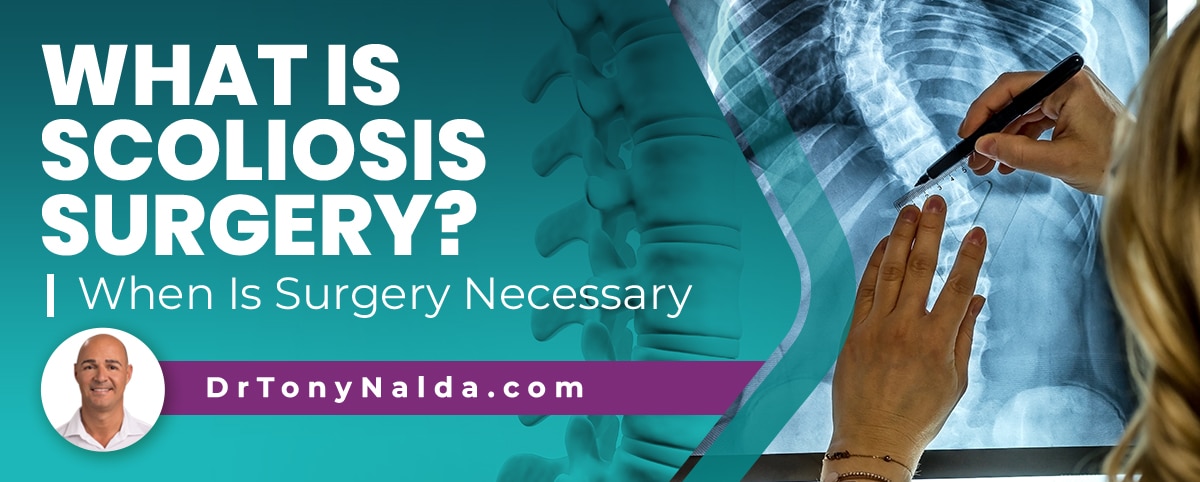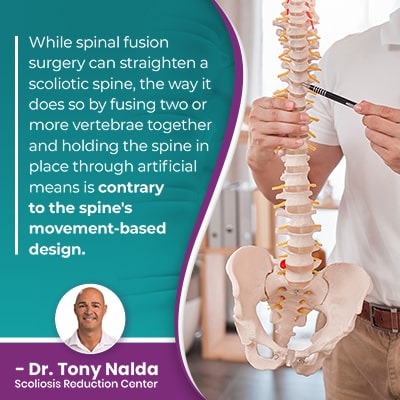What is Scoliosis Surgery? When Is Surgery Necessary?

While we don't always know what causes idiopathic scoliosis to develop initially, we do know what triggers its progression: growth. As a progressive spinal condition, the nature of scoliosis is to get worse over time, and this makes it more complex to treat, hence the benefit of a proactive treatment approach that works towards preventing progression.
There are different ways to treat scoliosis, and not all involve surgery; in fact, with early detection and intervention, there are fewer limits to what non-surgical conservative treatment can achieve. In traditional scoliosis treatment, surgical treatment is commonly recommended for severe scoliosis.
Let's start our discussion on scoliosis surgery by explaining the difference between mild, moderate, severe, and very severe scoliosis.
Table of Contents
How is Condition Severity Determined?
Condition severity is a key piece of information that treatment plans are shaped around, and it's also a piece of information that's needed to diagnose scoliosis and reach a surgical recommendation.
Scoliosis involves the development of an unnatural sideways curvature of the spine that also rotates, making it a complex 3-dimensional condition.
Now as a progressive condition whose nature is to get worse over time, where a condition's severity is at the time of diagnosis isn't necessarily indicative of where it will stay.
Condition severity is determined by a measurement known as Cobb angle, and in order to be considered a true scoliotic curve, the Cobb angle has to be a minimum of 10 degrees.
Cobb angle is determined during X-ray by drawing lines from the tops and bottoms of the curve's most-tilted vertebrae at its apex, and the resulting angle is expressed in degrees.
The higher the Cobb angle, the further out of alignment the spine is, and the more severe the condition:
- Mild scoliosis: Cobb angle measurement of between 10 and 25 degrees
- Moderate scoliosis: Cobb angle measurement of between 25 and 40 degrees
- Severe scoliosis: Cobb angle measurement of 40+ degrees
- Very-severe scoliosis: Cobb angle measurement of 80+ degrees
Not only is a patient's Cobb angle measurement needed to diagnose the condition and classify its severity, it's also a parameter that has to be met for patients undergoing traditional scoliosis treatment to be considered surgical candidates.
What is Spinal Fusion Surgery for Scoliosis?
 So scoliosis causes the spine to lose its healthy curves, and this introduces a lot of uneven forces not just to the spine and its surrounding muscles and nerves, but also the entire body.
So scoliosis causes the spine to lose its healthy curves, and this introduces a lot of uneven forces not just to the spine and its surrounding muscles and nerves, but also the entire body.
As an unnaturally-bending and twisting spine causes so many effects felt throughout the body, as much of the spine's healthy curves as possible need to be restored in order to reverse and/or improve the condition's effects.
The goal of spinal fusion surgery for scoliosis is to stop progression, and this isn't the same as working towards correcting scoliosis; corrective results require a non-surgical treatment response.
For those on the path of traditional scoliosis treatment, this is a common scenario; an adolescent is diagnosed with mild adolescent idiopathic scoliosis, and because it's mild and traditional treatment doesn't have a strategy for addressing scoliosis while mild, the patient is told to return for reassessment in one to three months.
As mentioned earlier, growth is what triggers scoliosis progression, so what happens if that adolescent patient, who is going through puberty, has one or more rapid and unpredictable growth spurts in between assessments, and it causes their scoliosis to progress significantly?
For one thing, the scoliosis has become more complex to treat; as the size of a scoliotic curve increases, the spine becomes increasingly rigid, making it less responsive to treatment.
As scoliosis progresses, the condition is becoming more severe, and this means its effects are going to become more noticeable; in children, that's postural deviation, and in adults, the main condition effect is pain.
How is Spinal Fusion Performed?
The process of spinal fusion is lengthy and invasive, and as the procedure carries some serious potential risks, side effects, and complications, it should be considered carefully.
There are different types of spinal fusion, but it commonly involves fusing the curve's most-tilted vertebrae at its apex into one solid bone, and this also commonly involves the removal of intervertebral discs that sit between adjacent vertebrae to be fused.
Then metal rods are attached to the spine with pedicle screws to hold it in place, and the goal is that as the most-tilted vertebrae have been fused into one solid bone, they can't become more tilted over time (progress).
 While spinal fusion surgery can straighten a scoliotic spine, the way it does so by fusing two or more vertebrae together and holding the spine in place through artificial means is contrary to the spine's movement-based design.
While spinal fusion surgery can straighten a scoliotic spine, the way it does so by fusing two or more vertebrae together and holding the spine in place through artificial means is contrary to the spine's movement-based design.
In addition to risks associated with the procedure itself (excessive blood loss, infection, and nerve damage), the long-term effects of spinal surgery are what I want patients to really be aware of.
The truth is that there is a large gap in the research on long-term effects of living with a fused spine 20, 30, 40+ years down the road, but what we do know is that spinal instrumentation used can't last forever, the younger the patient is, the longer the hardware has to perform optimally, and the only recourse if a fusion fails or hardware malfunctions or breaks over time is more surgery.
Once a spine is fused, it's fused for life, and the risks of surgical treatment only increase with each subsequent procedure and increasing patient age.
Fusing the spine and removing intervertebral discs comes at a price, and that price is the spine's long-term health and function.
A spine that's fused is weaker and more vulnerable to injury, and what many patient stories report is that the noticeable loss in spinal flexibility and range of motion has impacted quality of life.
In addition, due to increased spinal rigidity, many patients also experience an increase in back pain post spinal fusion.
Turning to a surgical procedure to treat structural scoliosis still has its merits in severe cases, but when the spinal bones can be adjusted manually through chiropractic care, and core strength can be increased through physical therapy so a scoliotic spine can receive optimal support/stabilization, a corrected spine tends be stronger, more flexible, and healthier in the long term.
Conclusion
Scoliosis surgery offers a traditional treatment response, and while spinal fusion surgery for scoliosis was the dominant response for many years, it was neither the best, nor only treatment option available.
As traditional treatment doesn't have a strategy for treating scoliosis while mild, patients can miss out on the benefit of early detection and intervention; early detection is only valuable if an early diagnosis is responded to proactively.
As a progressive spinal condition that's virtually guaranteed to get worse over time, waiting to start treatment is wasting valuable treatment time, and if it's allowing a scoliotic curve to progress unimpeded, this is only making the condition more complex to treat.
When scoliosis is diagnosed early in a condition's progressive line, treatment can be started while the condition is still mild, the curve size is small, significant progression hasn't yet occurred, and the condition's effects have yet to become well established.
There are never treatment guarantees, but when it comes to scoliosis, it's far more effective to work towards preventing progression than it is to attempt to reverse its effects once they're established.
When it comes to children, the main effects involve postural changes such as uneven hips, uneven shoulders, shoulder blades, and the development of a rib hump, and while adult scoliosis also involves postural deviation, the main effect is back pain and radiating pain due to spinal nerves and spinal roots being compressed inside, and where they exit, the spinal canal.
Scoliosis patients who have not yet reached skeletal maturity don't tend to find the condition painful because scoliosis doesn't become a compressive condition until growth has stopped.
If left untreated and/or in severe cases, scoliosis patients can develop complications such as disruptions to lung function and digestive issues.
Here at the Scoliosis Reduction Center, I customize each and every treatment plan to address key patient/condition variables, and because I feel that scoliosis surgery is risky and can negatively impact long-term spinal health and function, I use proactive conservative treatment to help patients avoid the hardships of progression and a spinal fusion recommendation.
If an unnatural spinal curvature has developed and a diagnosis of scoliosis has been given, as a progressive condition, regardless of type or severity, the best time to start treatment is always now.
Dr. Tony Nalda
DOCTOR OF CHIROPRACTIC
After receiving an undergraduate degree in psychology and his Doctorate of Chiropractic from Life University, Dr. Nalda settled in Celebration, Florida and proceeded to build one of Central Florida’s most successful chiropractic clinics.
His experience with patients suffering from scoliosis, and the confusion and frustration they faced, led him to seek a specialty in scoliosis care. In 2006 he completed his Intensive Care Certification from CLEAR Institute, a leading scoliosis educational and certification center.
About Dr. Tony Nalda
 Ready to explore scoliosis treatment? Contact Us Now
Ready to explore scoliosis treatment? Contact Us Now





